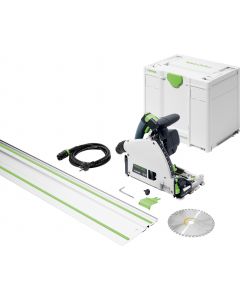How to use...
In action
Versions
Plunge-Cut Saws: Blade Size
Selecting the right blade size and type for your plunge cut saw—or track saw—is critical. With the correct blade, you’re a step closer to smoother, more precise cuts. Festool has a range of high-quality blades best suited to your plunge saw, created to meet the needs of every tradie or DIY enthusiast. For versatility and accuracy in various applications, you must select the correct blade size, width, and teeth.
Why the correct blade size is critical
When choosing a blade for your Festool plunge saw, it’s essential to consider the size of the blade. To select the correct size blade, you’ll begin with finding out what size blades are compatible with your model of plunge cut saw. The larger models, such as the Festool TS 75 plunge saw, are designed to use blades up to 210mm in diameter, while the smaller Festool TS 55 model uses 160mm blades. An incorrect blade size won't fit.
Choosing the correct blade thickness
Blade thickness, or kerf, affects the blade's performance, precision, and durability. Thicker blades are said to stay sharper for longer but can put more strain on the motor of the plunge saw. Thinner blades tend to offer a finer, faster cut. It’s important to note that when choosing the correct blade, look for one suited to the material you are working with rather than seeking only a particular thickness.


Plunge saw blade teeth:
Another critical factor when choosing your saw blade is the tooth shape and count.
Tooth Count:
The number of teeth on a blade may range from as little as four to 80 or more. The number of teeth will vary depending on the type of material the blade is suited for and its purpose.
For wood, blades with fewer teeth are preferable for rip cuts along the grain, while a higher tooth count suits cross cuts across the grain.


TOOTH SHAPES


CROSS-CUT TOOTH
Bevelled alternatively to reduce the load on individual teeth and ensure smooth movement.


TRAPEZOIDAL CROSS-CUT TOOTH
Runs even more smoothly than blades with cross-cut teeth, achieving an even better quality cut.


TRAPEZOIDAL AND FLAT TOOTH
These shapes can be arranged alternately. The flat tooth ensures a clean cut, while the trapezoidal tooth performs the sawing.


FLAT TOOTH WITH VARIABLE CHAMFER
Cuts left and right alternately to relieve pressure on the individual teeth and ensure consistent quality.


FLAT TOOTH BLADE
Each tooth on a flat tooth blade will cut the same and is ideal for abrasive or harder materials such as steel.
Beyond the size of your plunge cut saw blade, choosing the right blade for the material is critical. Festool has made blade selection easy through colour coding.
Each blade has a band of colour around the centre hole. Yellow is for wood, red for laminate, blue for aluminium and plastics, and green for abrasive materials such as cement and fibre boards. Of course, many blades can be used on more than one type of material; those would have two bands of colour.
Now that you're familiar with plunge saw blades, explore our range to select the right one for your project.






